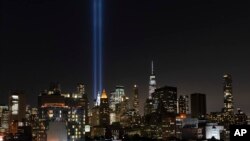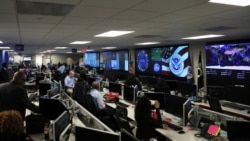For the past 18 years, there is one question that has rarely strayed for long from the minds of a majority of people living in the United States: Are we safe?
It is a question that was etched into the American psyche following the terror attacks of Sept. 11, 2001, when terrorists flew two planes into New York’s World Trade Center and another into the Pentagon, while a fourth crashed in a field in Pennsylvania.
“I looked out the window and I could see a mountain of concrete and steel just falling past the window, almost like in slow motion, like a curtain going down at a theater,” said Frank Razzano, who witnessed the collapse of the World Trade Center’s South Tower from his New York hotel room.
“I ran to the opposite side of the room and pressed myself against the wall and thought that those were the last few minutes that I was going to have on Earth,” he told VOA in 2013.
Since that day, the need to keep the U.S. safe from attack has been a constant for Americans, no matter their personal politics.
Top priority: protection from terrorism
According to a Pew Research Center survey, from 2002 through 2018, at least 7 in 10 U.S. adults said protecting the country from terrorism should be a top priority for both the president and lawmakers.
Eighteen years after the 9/11 attacks, the officials responsible for keeping the country safe say progress has been made.
“If you were to step back and think where we were … we are so much better off than we were on 9/12,” Frank Cilluffo, who worked in what was initially known as the Office of Homeland Security, told VOA.
“I think, by and large, the career civil servants and I think the 22 legacy agencies have recalibrated quite well to it to meet today’s demands and threats,” said Cilluffo, who now heads Auburn University’s McCrary Institute for Cyber and Critical Infrastructure Security.
But Cilluffo and other veteran officials called upon to make sure the U.S. would not again fall victim to a 9/11-type attack admit getting there was not easy.
One of the first steps was to create the Department of Homeland Security, which brought together key agencies such as the Transportation Security Administration (TSA), the Federal Emergency Management Agency (FEMA), the U.S. Coast Guard and the U.S. Secret Service.
It was the first step in an effort to correct what some experts and lawmakers had identified as a key weakness that allowed the 19 terrorists behind the Sept. 11, 2001, attacks to succeed — a failure of government agencies, some of which had vital bits of information about the plot, to communicate critical information and connect the dots.
Still, it wasn’t enough.
Determining mission
“Even then there was a challenge associated with trying to figure out what our mission profile really needed to be and the priorities within that mission profile,” said retired Admiral James Loy, who served as the new department’s first deputy secretary. “What was the business of this new department and how were we going to set about pulling it off?”
They settled on five words: awareness, prevention, protection, response and recovery.
“Those five words became the license, if you will, for all of us to continue doing what we were doing and begin the process of trying to do other things collaboratively that had never been done perhaps by this particular gathering,” Loy recalled at a gathering of former DHS deputy secretaries Wednesday.
There were also adjustments that had to be made by the many officials who came to DHS either from the military or the intelligence community.
“I found out that everything I thought I knew about the role of the federal government in dealing with security was wrong,” said Jane Holl Lute, who served as a DHS deputy secretary under U.S. President Barack Obama.
“Your relationship between the public, government and fear is very different,” she said.
Instead of concentrating on carefully gathered information from well-placed spies or sources, DHS had to learn to partner with civilians.
“The men and women of this country know an enormous amount about what’s happening,” Lute said. “We actually found out that streetcar vendors in Times Square in New York have pretty valuable information.”
Lute and other former and current officials are confident that the government has been able to find ways to reach out to civilians and even to private businesses.
Still, as the threats have evolved to include disinformation campaigns and cyber attacks, they say more will need to be done.
‘Woefully inadequate’
Some officials also see shortcomings despite yearly budgets that have more than doubled since Congress set aside $19.5 billion for Homeland Security in 2002.
“If you look at the infrastructure of the department, it is woefully inadequate,” said Paul Schneider, another former deputy secretary. He added that so much money is tied up in mandatory programs, such as disaster relief, that there is little left to make needed improvements.
“There’s CBP [Customs and Border Patrol] Border Patrol stations that look like, you know, a 1950s cowboy movie of the Pony Express,” he said.
But one of the biggest challenges for homeland security officials may be overcoming the language that so many in the U.S. have come to associate with the department — the war on terror.
“Our war on terror begins with al-Qaida, but it does not end there,” former President George W. Bush told a joint session of Congress nine days after the 2001 attacks. “It will not end until every terrorist group of global reach has been found, stopped and defeated.”
It was a powerful message in the wake of tragedy. But former officials, like Cilluffo, admit it is a war that can never really be won.
“The reality is there’s never an end state,” Cilluffo said. “It’s something that we have to continually adapt, continually prioritize and continually get the job done.”













